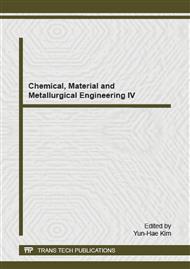p.335
p.339
p.343
p.348
p.352
p.360
p.365
p.369
p.374
Study on the Modification of Blast Furnace Smelt Slag and Crystallization Behavior in the Solidification Process
Abstract:
The direct fibrillation of blast furnace slag can solve these problems, such as having not been recycled of sensible heat, the consumption of water resources, environmental pollution and the low additional value of product, which are caused by the traditional water quenching method. The modification is the key problem of fiber forming. The thesis mainly aims at the study of viscosity of slag, the ability of crystallization and mineral phase structure after the modified process of blast furnace slag and confined the relevance of the three to optimize the appropriate texturizer and adding ratio. The results are as following: Iron ore waste rock, fly-ash and compounded texturizer can improve the high temperature viscosity of the slag respectively, while it has different effect on landing gradient of viscosity and temperature (Fly-ash occupies first place, compounded texturizer comes second and iron ore and waste rock comes the minimum). By analyzing the crystallization behavior of the slag in the solidification process, when the proportion of iron ore waste rock is more than 9%, the fly-ash is equal or greater than 8% and the compounded texturizer is more than 9%, the solidification slag will appear amorphous. The mineral composition of the slag transforms gradually from melilite to vitreous body, which will make the air hole of the vitreous body increased and aperture decreased. When the iron ore waste rock is added, the homogeneity of the air hole will deteriorate, while adding the fly-ash and compounded texturizer will strengthen the homogeneity of the air hole and make the mineral structure intensive gradually.
Info:
Periodical:
Pages:
352-359
Citation:
Online since:
March 2015
Authors:
Price:
Сopyright:
© 2015 Trans Tech Publications Ltd. All Rights Reserved
Share:
Citation:


